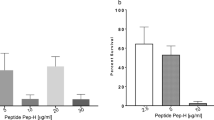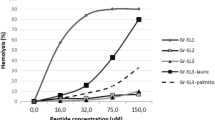Abstract
The secondary intracellular target of human neutrophil peptide-1 has been examined in M. tuberculosis H37Ra. Binding studies with radioiodinated HNP-1 revealed biphasic equilibrium binding kinetics with respect to time. The major site of HNP-1 binding was found to be plasma membrane/cell wall whereas the cytosol appears to be a secondary site. Among the different macromolecules examined, maximum inhibition (75%) was observed in DNA biosynthesis during treatment with HNP-1. The interaction of HNP-1 with mycobacterial genomic DNA on the basis of gel retardation assay revealed HNP-1 binding to DNA. These results indicate that HNP-1 has DNA as the secondary intracellular target for antibacterial action against mycobacteria.
Similar content being viewed by others
Author information
Authors and Affiliations
Additional information
Received: 25 October 2000/Accepted: 10 January 2001
Rights and permissions
About this article
Cite this article
Sharma, S., Khuller, G. DNA as the Intracellular Secondary Target for Antibacterial Action of Human Neutrophil Peptide-I Against Mycobacterium tuberculosis H37Ra. Curr Microbiol 43, 74–76 (2001). https://doi.org/10.1007/s002840010263
Issue Date:
DOI: https://doi.org/10.1007/s002840010263




